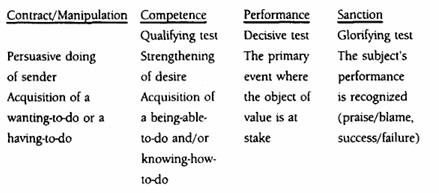
Canonical narrative schema
 المؤلف:
Bronwen Martin and Felizitas Ringham
المؤلف:
Bronwen Martin and Felizitas Ringham
 المصدر:
Dictionary of Semiotics
المصدر:
Dictionary of Semiotics
 الجزء والصفحة:
P32
الجزء والصفحة:
P32
 2025-05-14
2025-05-14
 556
556
Canonical narrative schema
This schema presents a universal prototype for the structure of narrative. It is composed of three tests: the qualifying test, the decisive test and the glorifying test, which unfold in a logical succession. These tests are preceded by the stage of manipulation or contract.

This narrative macro-structure can be exploited by individual texts in a variety of different ways. Certain stages or tests may be foregrounded, others remain implicit: in adventure stories, for example, the emphasis is on the decisive test, whereas legal discourse is centred more on the stage of sanction.
Contract/manipulation: The sender transmits to the receiver the desire or obligation to act. What is known as a contract is established between the two and the subject embarks on a quest. The contract is followed by three tests. These tests mirror the fundamental logic of human action:
The qualifying test (or stage of competence): Here the subject acquires the necessary competence needed to carry out the planned action or mission. The desire or obligation to act is not in itself sufficient: the subject must also possess the ability to act (pouvoir faire) and/or the knowledge/skills to do so (savoir/aire). For example, if your intention is to shoot someone, you first of all need to acquire a gun; the gun functions as your helper, providing you with the necessary ability to act.
The decisive test (or stage of performance): This represents the principal event or action for which the subject has been preparing, where the object of the quest is at stake. In adventure stories or newspaper articles, the decisive test frequently takes the form of a confrontation or conflict between a subject and an anti-subject.
The glorifying test (or sanction): The outcome of the event is now revealed, the decisive test has either succeeded or failed, the subject is acclaimed or punished. In other words, it is the point at which the performance of the subject is interpreted and evaluated by what is known as the sender-adjudicator.
For more details see under individual headings
 الاكثر قراءة في Semiotics
الاكثر قراءة في Semiotics
 اخر الاخبار
اخر الاخبار
اخبار العتبة العباسية المقدسة


